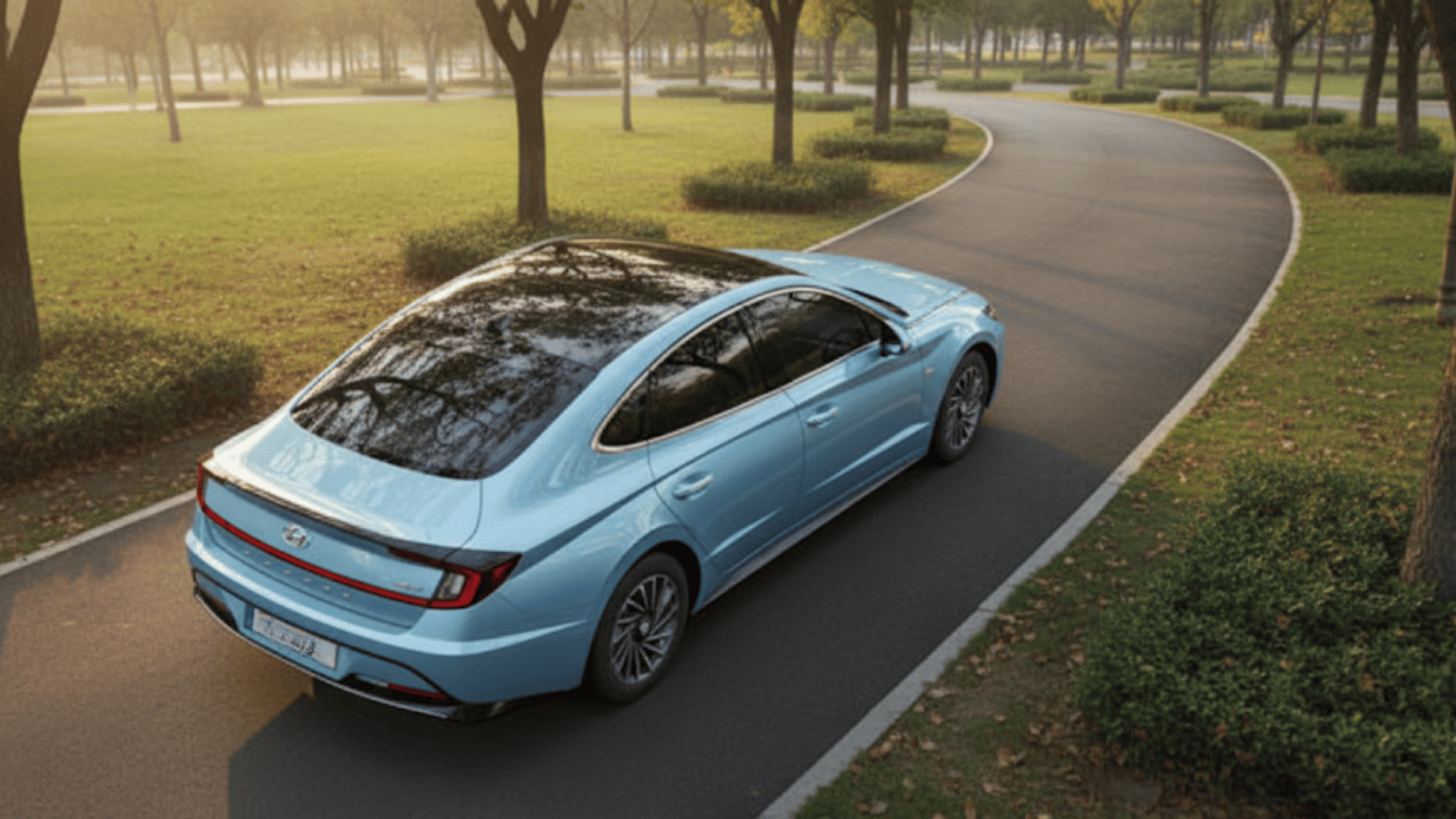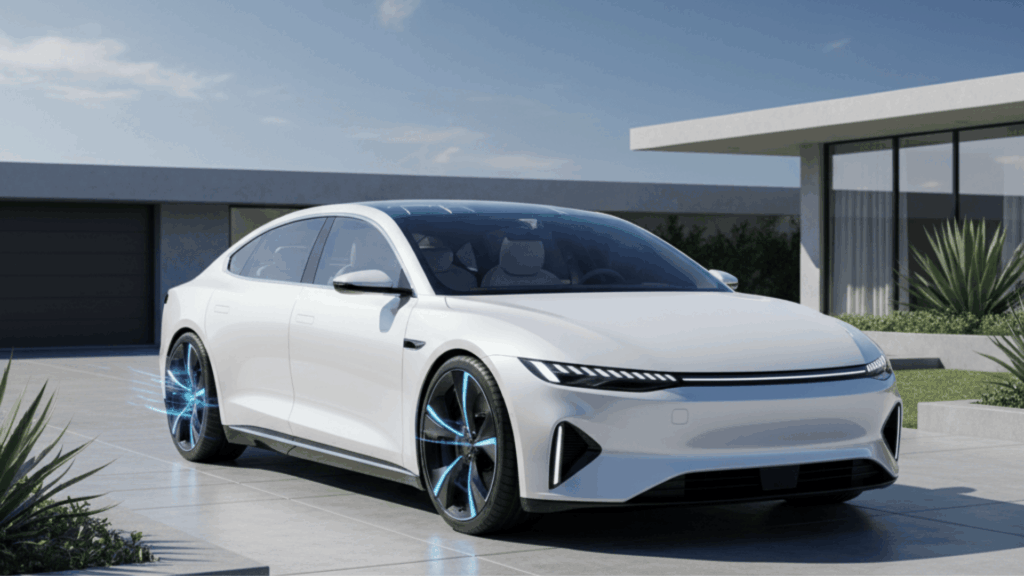Want better gas mileage, but don’t have anywhere to plug in an electric vehicle at your home or apartment building? A self-charging electric car might sound like the perfect solution since it promises fuel savings without needing charging stations.
I’ve put together everything you need to know about how these hybrid vehicles actually work and whether they’re right for you.
You’ll learn what makes them different, why the “self-charging” name causes confusion, and when they make the most sense financially.
The truth about these cars is simpler than all the marketing hype suggests, once you understand the basic technology. Let me show you exactly what a self-charging electric car can and cannot do for your daily driving.
This content is for informational purposes only and should not replace professional advice from certified automotive experts or mechanics.
What is a Self-Charging Electric Car?
Self-charging electric cars are hybrid vehicles that generate their own electricity while you drive rather than plugging into external charging stations.
These cars use a gasoline engine combined with an electric motor and battery to power themselves during trips on the road. The term “self-charging” is essentially marketing language for full hybrid systems, which differ from mild hybrids that can’t drive on electric power alone.
Self-charging hybrids and full hybrids are the same thing, offering electric-only driving for short distances, unlike mild hybrids.
The term sounds impressive, but it can be misleading because these vehicles don’t actually charge themselves from nothing or thin air.
They still rely on burning gasoline to create electricity that charges their batteries through regenerative braking and the engine.
How Self-Charging Hybrid Cars Actually Work?

Self-charging hybrids use a smart system where the gas engine and electric motor work together based on driving conditions. Here’s how I’ll break down the energy flow between these components so you can see why these cars save fuel:
The Engine and Electric Motor Connection
The engine and electric motor work as teammates, each helping when needed. The gas engine powers the car at higher speeds or when extra power is needed. The electric motor can run the car alone at low speeds, saving fuel.
When you brake or slow down, regenerative braking captures energy that usually goes to waste. This energy charges the battery, which later powers the electric motor to assist the engine or drive on its own.
Energy Flow in Real Driving Conditions
Energy moves back and forth between the gas engine and electric motor depending on driving. During acceleration, both join forces for strong power. While braking, energy is saved by regenerative braking, like how a bicycle dynamo stores power when moving.
When cruising, the gas engine runs smoothly and efficiently. This flow helps the car conserve fuel and produce less pollution while driving in real life.
Solar/Alternative Energy Integration in EV

Solar and alternative energy integration pushes hybrid technology further by capturing power from sources beyond just gasoline and regenerative braking.
Solar-assisted hybrid models add photovoltaic panels on car roofs and body panels to generate extra electricity from sunlight during driving.
These solar panels provide supplemental power that extends the electric range slightly, though they can’t fully charge batteries due to limited surface area.
Energy harvesting from other sources, such as thermoelectric converters and vibration capture, adds even more power from waste heat and motion.
Examples like Lightyear and Aptera prototype vehicles showcase how solar integration works in real cars with impressive efficiency.
Self-Charging vs. Plug-In Hybrids vs. Electric Cars
Understanding the differences between self-charging hybrids, plug-in hybrids, and fully electric cars helps you choose the right vehicle for your needs. Here’s how these three types of eco-friendly vehicles compare across key features and daily use:
| Feature | Self-Charging Hybrid | Plug-In Hybrid (PHEV) | Electric Car (EV) |
|---|---|---|---|
| Power Source | Gas engine + electric motor | Gas engine + larger battery + electric motor | Battery only |
| Charging Method | Regenerative braking + engine | Plug-in charging + regenerative braking | Plug-in charging only |
| Electric-Only Range | 1-2 miles | 20-50 miles | 150-400+ miles |
| Fuel Dependency | Requires gasoline | Requires gasoline (backup) | No fuel needed |
| Charging Infrastructure | No external charging needed | Home or public charging stations | Home or public charging stations |
| Best For | City driving, fuel savings without charging | Short commutes on electric, long trips on gas | Daily commutes, eco-conscious drivers |
| Initial Cost | Lower than PHEV or EV | Mid-range pricing | Higher upfront cost |
Each vehicle type offers unique advantages depending on your driving habits, budget, and access to charging infrastructure at home. Choose self-charging hybrids for convenience, plug-in hybrids for flexibility, or electric cars for maximum environmental benefits and lowest running costs.
Policy, Incentives, & Regulatory Dynamics
Governments use policies and incentives to push hybrid car use and cleaner transport. In the US, the Environmental Protection Agency (EPA) offers tax credits and subsidies to make hybrids more affordable.
Strict fuel-efficiency and emissions rules push automakers to produce more hybrids. Some states set limits or bans on pure gas cars, making hybrids a bridge to cleaner transport.
Infrastructure support, like more charging stations and upgraded electric grids, helps make hybrids practical.
Together, these efforts make hybrids an important step towards greener, affordable transportation as the country shifts to electric vehicles.
Advantages of Self-Charging Hybrid Cars
Self-charging hybrid cars offer several practical benefits that make them appealing for drivers who want better fuel economy without charging hassles. Here are the main advantages that set these vehicles apart from traditional gas cars and fully electric options:
- No need for charging stations: Self-charging hybrids are perfect for users without home charging setups, making them convenient for city dwellers and apartment residents.
- Improved fuel efficiency and lower emissions: These cars consume less fuel during stop-and-go traffic by using the electric motor, reducing CO₂ output for environmental benefits.
- Smooth and quiet driving experience: The electric drive makes city driving quieter and more peaceful, especially at low speeds when the motor runs silently.
- Lower maintenance than full EVs: Hybrids have smaller batteries and fewer charging components, leading to cost savings on repairs and battery replacement over time.
These benefits make self-charging hybrids an excellent middle ground for drivers transitioning from gas cars to greener options. You get fuel savings and environmental benefits without worrying about finding charging stations or installing home charging equipment every single day.
Drawbacks and Criticism of Self-Charging Hybrids
Self-charging hybrids offer benefits but also come with limitations that potential buyers should understand before making a purchase decision. Here are the main criticisms and risks associated with these vehicles:
- Overpromising and consumer disappointment happen when marketing claims about fuel savings don’t match real-world performance in actual driving conditions.
- Battery health risks increase when cars sit idle for long periods, as hybrid batteries degrade faster without regular use and cycling.
- Emissions advantages get overstated in certain conditions, especially on highways where the gas engine runs constantly and electric assist provides minimal benefit.
- High Maintenance complexity and replacement costs exceed traditional cars because hybrids have both gas and electric systems, requiring specialized knowledge and expensive parts.
Understanding these drawbacks helps you set realistic expectations about ownership costs and environmental impact before buying any self-charging hybrid.
Always research real owner experiences rather than relying solely on manufacturer claims and marketing materials for accurate information.
Popular Self-Charging Hybrid Models
Several major automakers offer self-charging hybrid models that combine proven reliability with excellent fuel economy for everyday driving needs. Here are some of the most popular self-charging hybrids available today with their key specifications and performance details:
| Model | Fuel Economy (mpg) | Electric-Only Range | Engine Specs | Best For |
|---|---|---|---|---|
| Toyota Prius Hybrid | 54 city / 50 highway | 1-2 miles | 1.8L 4-cylinder + electric motor, 121 hp combined | Daily commuters seeking proven reliability and excellent fuel economy |
| Lexus UX 250h | 43 city / 41 highway | 1-2 miles | 2.0L 4-cylinder + electric motor, 181 hp combined | Luxury seekers wanting premium features with hybrid efficiency |
| Kia Niro Hybrid | 53 city / 48 highway | 1-2 miles | 1.6L 4-cylinder + electric motor, 139 hp combined | Families needing crossover space with great fuel savings |
| Hyundai Ioniq Hybrid | 58 city / 60 highway | 1-2 miles | 1.6L 4-cylinder + electric motor, 139 hp combined | Budget-conscious drivers wanting top-tier fuel efficiency |
These models represent the best options currently available if you want hybrid benefits without the hassle of plugging in overnight. Each vehicle offers unique advantages depending on your budget, lifestyle, and if you prioritize luxury, space, or maximum fuel savings.
Future of Self-Charging Technology in Hybrid EVs
The future of hybrid technology looks promising as engineers develop smarter systems that deliver better performance, efficiency, and convenience for drivers.
Next-generation hybrids will feature ultra-efficient engines with high compression ratios and advanced combustion cycles that squeeze more power from less fuel.
Solid-state batteries promise higher energy density and faster charging, making hybrid systems more powerful without adding weight or bulk.
AI and predictive energy management will learn your driving patterns to automatically optimize when the car uses electric versus gas power.
Bi-directional energy flow technology will let hybrids send power back to your home during emergencies or peak demand.
Owner Experiences with Self-Charging Hybrids

Real-life experiences with self-charging hybrids show how practical and fuel-saving these cars can be. Owners say the cars switch quietly between gas and electric power without needing to plug in every night.
Many enjoy the smooth, silent electric mode for short trips and appreciate saving money on gas. Some users share tips for keeping their hybrids running efficiently.
A common praise is for the gas savings and reliability. For detailed owner stories and insights, check out this helpful discussion on Reddit where people explain how these hybrids work in everyday life. This helps new buyers learn what to expect.
Should You Buy a Self-Charging Hybrid Car?
Self-charging hybrids make the most sense for urban drivers, daily commuters, and eco-conscious buyers who want fuel savings without charging hassles.
These cars work best in city driving with low speeds and stop-and-go traffic, where regenerative braking captures the most energy.
They perform worst during long highway driving or high-load situations, where the gas engine runs constantly without the benefits of electric assist.
Long-term costs fall between traditional gas cars and full-electric vehicles, offering savings on fuel without the expense of home charging.
Self-charging hybrids suit urban residents without home charging access, apartment dwellers, and fleet buyers who make frequent short daily trips.
Geography, climate, and terrain significantly affect viability, as cold weather reduces battery efficiency and mountainous terrain drains batteries faster.
Final Words
A self-charging electric car bridges the gap between traditional gas vehicles and fully electric models for drivers without charging access. I hope this breakdown showed you how these hybrids work and helped you decide if one fits your lifestyle and budget.
The key is understanding that “self-charging” really means the car uses gasoline to generate electricity rather than creating power magically from nowhere.
These vehicles shine in city driving, where regenerative braking captures the most energy throughout your commute and errands daily.
Your decision should depend on where you live, how you drive, and if you can install home charging equipment. What’s holding you back from switching to a hybrid or electric vehicle? Share your main concerns in the comments below.

